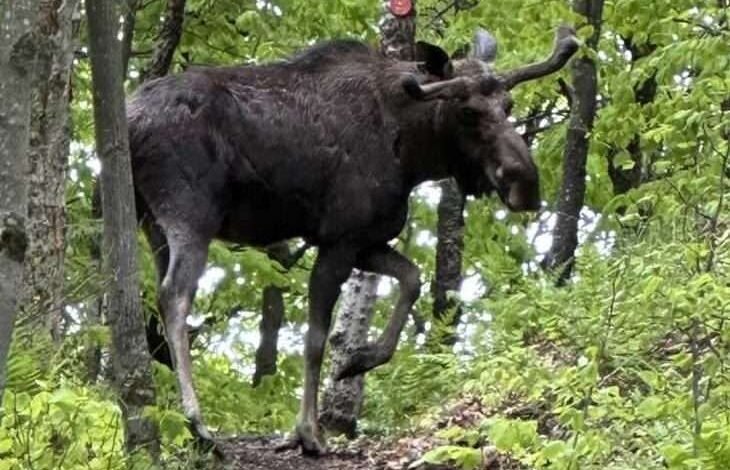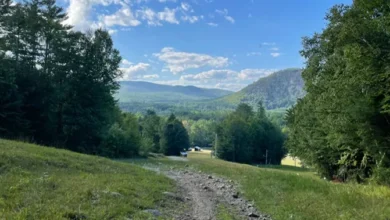Moose That Closed Adirondack Hiking Trail Euthanized


 On August 6th, the New York State Department of Environmental Conservation (DEC) euthanized a bull moose on the Goodman Mountain Trail after confirming a significant decline in its health.
On August 6th, the New York State Department of Environmental Conservation (DEC) euthanized a bull moose on the Goodman Mountain Trail after confirming a significant decline in its health.
The moose was first sighted near the summit of Goodman Mountain in May when hikers reported the moose tolerating close human presence.
“After assessing the moose’s condition, public safety issues related to its chosen location near the summit, and attempts to haze the moose to encourage voluntary movement away from the trail, DEC temporarily closed the trail to protect the moose and the recreating public,” an announcement from the department said.
According to the announcement, DEC and the New York State wildlife veterinarian monitored the moose throughout the summer using trail cameras and in-person site visits and noted a progressive decline in the animal’s body condition and delayed response to human presence.
During a site visit on Aug. 6, wildlife biologists and the New York State veterinarian say they observed advanced signs of disease, including severe emaciation, and determined euthanasia to be the most humane course of action.
“DEC closely monitors the moose population across the Adirondack region to understand overall moose health, including the presence of underlying diseases that may impact New York’s moose population,” DEC Director of the Division of Fish and Wildlife Jacqueline Lendrum said.
“Following a thorough assessment, DEC experts made the difficult decision to euthanize the moose due to its deteriorating condition and low likelihood of survival. DEC’s priority is always the well-being of wildlife and public safety. While we never take such actions lightly, humane euthanasia is sometimes the most responsible course of action. In addition, information gathered from this animal will help DEC better understand and manage moose in New York.”
“The moose’s health had clearly deteriorated over time,” Cornell College of Veterinary Medicine Assistant Professor of Practice at the Department of Public and Ecosystem Health Dr. Jennifer Bloodgood, said.
“Performing a necropsy will help us to understand the cause of the decline and give us more information on threats to moose health in New York State.”
“DEC continues to assess the moose population in New York, including wildlife health tracking and monitoring and population studies and surveys,” the announcement said.
“Euthanizing a moose, or any animal, is always a last resort and DEC only advances euthanasia when the animal is suffering or presents an immediate public health or safety risk.”
DEC said the Department is planning to conduct a post-mortem necropsy to help determine the potential cause of the moose’s failed health and unusual behavior and share information as it becomes available.
In the short term, the Goodman Mountain Trail will remain closed while DEC completes a study of the area to evaluate evidence of the foraging behavior and habitat range of this animal.
DEC Forest Rangers will continue patrolling the area. Once DEC’s work is completed, the barriers will be removed and the trail reopened.
DEC plans to update the public when the area is clear and the trail is open for public access. That information will be sharede in John Warren’s weekly Adirondack Outdoor Recreation Conditions Report at North Country Public Radio (NCPR).
About Moose in the Adirondacks
Moose occur in boreal forest areas of the Northern Hemisphere. In North America, moose are found from Alaska eastward to the Atlantic Ocean, and south into the Rocky Mountains, northern Great Lakes, and the Northeast.
Moose entered New York State on a continuous basis in the 1980s, having been absent since the 1860s and are currently located in the northeastern part of the state in the Adirondack Mountains and the Taconic Highlands along the Massachusetts and Vermont borders.
Moose are primarily browsers, feeding on the leaves, twigs, and buds of hardwood and softwood trees and shrubs. An adult moose eats 40 to 60 pounds of browse every day.
Favored plant species include willows, birches, maples, balsam fir, viburnums, aspen, and mountain ash. In the winter, moose may strip and eat the bark from small trees, usually maples and aspen.
In the summer, moose feed heavily on aquatic plants in ponds and wetlands, wading into the water and reaching beneath the surface for plants. They also depend on these wet areas to escape from biting insects and hot weather.
Ideal moose habitat consists of a mosaic of upland mature mixed forest, open areas created by burns or logging, and wetlands.
The regrowth of browse species after a fire or clearcut offers nutritious food in large quantities needed by moose. Small clear-cuts with some softwood cover retained are better than large clear-cuts of more than 100 acres.
DEC Wildlife staff regularly respond to and monitor situations related to wildlife in contact with humans.
Most situations do not need intervention; however, when wandering animals like moose or bear show up in unusual places, DEC’s goal is for the animal to return to wild areas on their own, as unnecessary intervention and handling of the animal can lead to stress and death.
It is uncommon behavior for moose to spend extended periods of time in the presence of people or buildings and such behavior can be an indicator of significant health issues.
In New York State, automobile accidents are the leading cause of death for moose; the second cause of death are those related to parasites like liver fluke and brain worm.
White-tailed deer are a host to flukes and have a great tolerance for the parasite. Moose, however, are particularly susceptible to an infestation and this is one reason moose and deer populations do not significantly overlap in their respective ranges.
For information about New York State’s Moose Research Project, visit this website.
Read more about moose in New York State.
Photo: One of many photos of the bull moose at Goodman Mountain Trail posted to social media.
Source link




